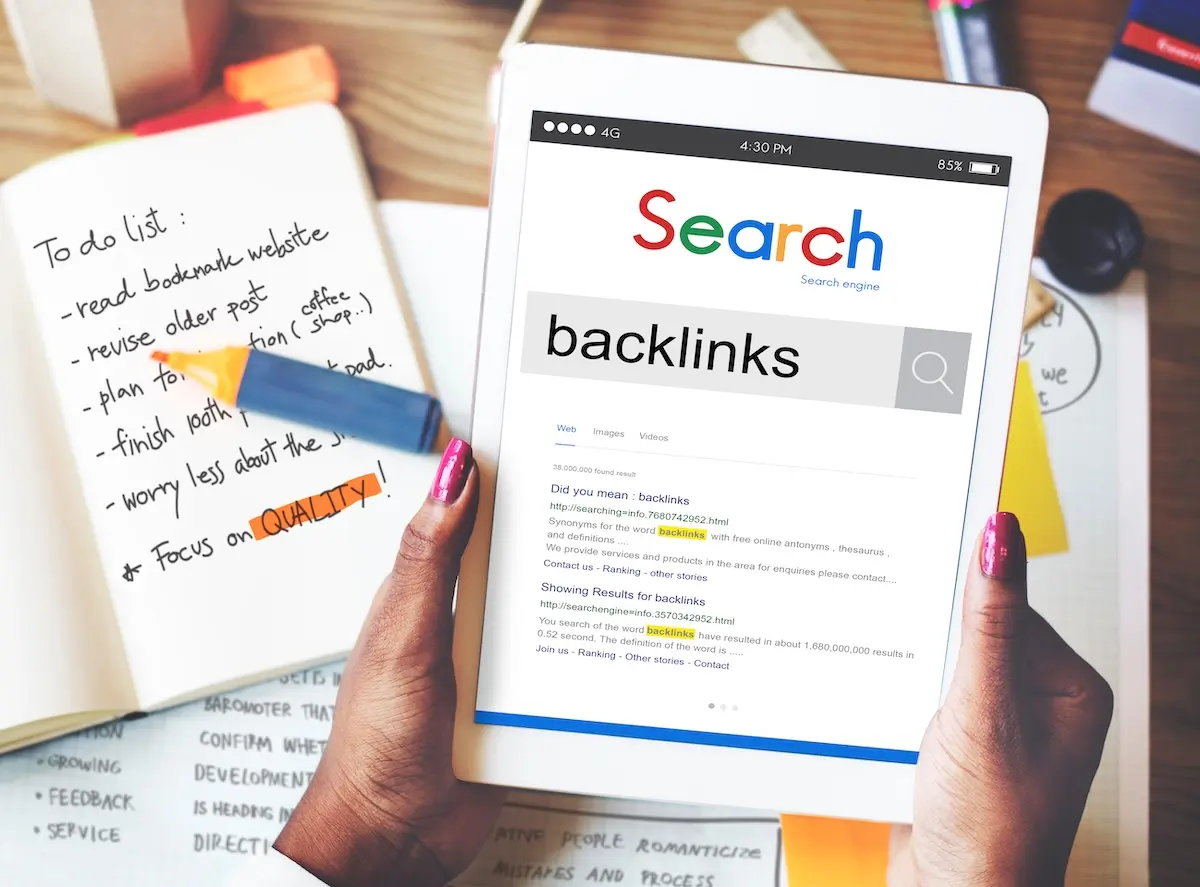Your content’s excellent. Your site’s fast. Your on-page SEO is dialed in. You’ve got backlinks. So why aren’t you ranking?
The missing piece is often the quality of your backlinks. The authoritative, relevant kind are the ones that signal trust to search engines and AI systems alike.
Search is changing fast. ChatGPT, Perplexity, and Google’s AI Overviews now summarize answers without always sending traffic your way.
But here’s what hasn’t changed: backlinks remain one of the strongest indicators of credibility and relevance.
Whether you want to rank higher in organic search, get cited by AI engines, or simply build brand authority, you need a backlink strategy rooted in quality and value, not shortcuts.
This guide breaks down exactly how to earn those links in 2025.
Table of Contents
- Why Backlinks Still Matter
- What Defines a Quality Backlink
- Quality vs. Quantity: The Real Answer
- 14 Proven Strategies to Earn Quality Backlinks
- How to Write Outreach That Gets Responses
- FAQ
- Final Thoughts
Why Backlinks Still Matter
Backlinks act as endorsements. Each one tells search engines, “This content deserves attention.”
Sites with stronger backlink profiles consistently rank higher. Recent data shows that over 96% of pages in Google’s top 10 results have backlinks from more than 1,000 unique referring domains.
But volume alone won’t cut it. Low-quality links from irrelevant or spammy sites can damage your credibility. What you need are editorial, contextually relevant backlinks from trusted sources.
Quality backlinks deliver:
- Referral traffic from engaged audiences
- Brand visibility and recognition
- Domain authority that compounds over time
The question is: how do you tell the difference between a backlink that helps and one that hurts?
What Defines a Quality Backlink
Strong backlinks share three core traits:
1. Relevance
The linking site covers topics related to yours. A backlink from a respected marketing blog to your SaaS tool carries weight. A random link from an unrelated forum doesn’t.
2. Authority
The source has established credibility. Think industry publications, educational institutions, or high-traffic competitors.
3. Editorial Placement
The link was earned naturally – not purchased, traded, or stuffed into a comment section.
According to digital PR specialists, a valuable backlink typically comes from a site with:
- Domain authority above 35
- Consistent monthly traffic (at least 1,000 visitors)
- Content that’s trustworthy and aligned with your brand
Bonus factors include contextual anchor text, placement early in the content, and strong engagement metrics on the linking page itself.
Earning these links takes effort, but the results last.
Quality vs. Quantity: Which is Better?

How many backlinks do you actually need?
The classic SEO answer: it depends.
Do you need thousands of backlinks? Not necessarily.
Would earning hundreds of strong backlinks help? Absolutely.
Both quality and quantity play a role, but quality always wins. Quantity helps diversify your link profile, especially from niche or mid-tier sites. Quality delivers the authority, trust, and ranking power that produces measurable outcomes.
The problem starts when marketers chase numbers for the sake of it. Buying links, trading links, or spamming comment sections. That approach doesn’t just fail; it actively damages your reputation and long-term rankings.
14 Proven Strategies to Earn Quality Backlinks
1. Lead With Value in Your Outreach
When reaching out to sites, make it about them, not you. Instead of asking, “Can you link to my article?” try:
“Your readers might find this resource helpful – it expands on the section you covered about [topic] with additional data.”
Show them how linking benefits their audience. If your content complements something already performing well for them, even better.
2. Publish Content Worth Citing
People link to the best resource, not just another article. To stand out:
- Go deeper than competitors
- Include original data, visuals, or expert insights
- Match search intent precisely
- Demonstrate E-E-A-T (Experience, Expertise, Authoritativeness, Trustworthiness)
For example, one agency created a data-driven report for a personal finance client that was unlike anything else available. The result? 20 backlinks from top-tier outlets like CNBC and Retail Wire.
The takeaway: Find the gap in existing content and fill it better than anyone else.
3. Build Trust Signals Into Your Site
Earning links is easier when your site looks professional and trustworthy. Include:
- HTTPS certification
- A branded domain
- High-quality design
- Links to active social profiles
- Contact information and company address
- E-E-A-T elements like an about page, editorial standards, and author bios
These signals reassure potential linkers that you’re legitimate.
4. Keep Outreach Emails Short
Want better response rates? Practice brevity. Your pitch should:
- Use single-line paragraphs (two sentences max)
- Stay under five sentences total
- Highlight key points with bullet points or bold text
- Clearly state what you’re asking for
Make it easy for recipients to understand your pitch and take action.
5. Use Digital PR to Earn High-Authority Links
Digital PR isn’t about self-promotion. It’s about creating newsworthy stories that journalists, bloggers, and industry outlets want to cover.
PR campaigns can land backlinks from the highest-authority sites: Forbes, TechCrunch, major trade publications. Those links carry far more weight than dozens of smaller blogs.
How to use it:
- Data-driven stories: Package survey results or industry insights. Journalists love fresh numbers.
- Expert commentary: Offer quick takes on trending news using platforms like HARO or Qwoted.
- Unique hooks: Tie your brand to bigger conversations (e.g., “State of Remote Work in 2025”).
High-quality backlinks come when your story provides genuine value to readers and publishers.
6. Conduct Original Research
Original research is a backlink magnet. Why? Because everyone needs data to support their content, and citing your study is easier than conducting their own.
You don’t need to be a research firm. Here’s how:
- Survey your customers or audience
- Analyze public datasets in a new way
- Use anonymized data from your own tools (if applicable)
One agency used multiple datasets to compare roadside restaurants across America for truck drivers. The geo-specific nature meant local news outlets could report on truck stops in their state. The result? Over 1,400 social shares and new rankings for “best truck stop food.”
7. Create Shareable Visuals
Infographics and original images are easier to share, embed, and link to than text-heavy articles. A great visual travels across social media, blogs, and news outlets.
How to do it right:
- Use tools like Canva or Venngage
- Focus on one core concept. Don’t cram everything in
- Include embed codes so other sites can easily share and link back
Visuals that provide real value get linked.
8. Offer Testimonials to Tools and Services You Use
Companies love showcasing happy customers. When they feature your testimonial, they usually link back to you.
How to make it happen:
- Reach out to SaaS tools, agencies, or vendors you use
- Offer a detailed testimonial highlighting specific results
- Include your full name, role, and website
These links come from trusted, established brands, making them high-value backlinks.
9. Link Out, Then Follow Up

Linking to other sites doesn’t give away visibility, it builds relationships. Here’s how:
- Write a blog post and naturally link to a relevant site, tool, or expert
- Reach out and let them know they’ve been included
- Start a conversation that may lead to reciprocal mentions or backlinks
This isn’t an overnight hack. It’s a trust-building move that snowballs into collaborations and citations.
10. Engage Authentically on Blogs and Social Media
Comments on blogs and social posts build relationships with people in your industry, and occasionally earn backlinks.
The key is adding value:
- Compliment the author’s work
- Add meaningful insight to the discussion
- Share your own perspective that invites response
The stronger your relationship, the more likely future backlink opportunities arise.
11. Align Your Social Signals
Social signals communicate to search engines how active and updated your website is. The more active, the better your rankings.
What to do:
- Link to all your social profiles in your website footer
- Post consistently on one or two platforms (at least once daily)
- Ensure company name, address, and phone number match across all profiles
This simple step builds rankings with minimal extra work.
12. Capitalize on Trending Topics
Timing matters. Tie your content to breaking stories or trends to increase your odds of earning backlinks from journalists and bloggers.
Where to find opportunities:
- Google Trends
- BuzzSumo
- Exploding Topics
For example, when Google rolls out a major algorithm update, an SEO agency could publish a quick analysis within 24 hours. Journalists writing about the update may cite that content, earning authoritative backlinks.
13. Turn Brand Mentions Into Backlinks
People may already be talking about your brand without linking to it. That’s low-hanging fruit.
Use tools like Mention, BuzzSumo, or Ahrefs Alerts to track unlinked mentions. Then reach out:
“Thanks for mentioning us in your piece on [Topic]. Would you mind adding a link so readers can easily find the resource?”
These links are easy wins.
14. Analyze Competitor Backlink Profiles
Your competitors’ backlinks are a roadmap for your strategy. If it’s working for them, it could work for you.
How to start:
- Use Ubersuggest, Ahrefs, or Semrush to pull competitor backlink reports
- Examine their most-linked content and referral domains
- Identify patterns: Are they earning links from directories? Guest posts? Data reports?
Once you know what they’re doing, ask: Can I create something better?
If a competitor earned a link for “2024 Social Media Trends,” publish a deeper “2025 Social Media Playbook.” Provide more value. Pitch it to the same sites.
How to Write Outreach That Gets Responses
Your content may be strong, but the pitch determines whether you earn the backlink.
A valuable pitch is:
- Short and personal: Under 100 words, customized for the recipient
- Value-driven: Show how your resource improves their article or helps their readers
- Clear: Include the exact link and context
- Credible: Reference your expertise or unique data
- Timely: Tie your pitch to something current
Example:
Hi [Name], I really enjoyed your recent piece on [Topic]. I noticed you mentioned [related stat], and we just released a new study with fresh data on this in 2025. I thought it might add value for your readers. Here’s the link: [URL]. Would you consider including it?
This approach blends relevance, authority, and timeliness. These are the qualities that make backlinks valuable.
FAQ
How do I get quality backlinks?
Focus on digital PR, original research, expert content, and smart outreach. Build real relationships and offer value.
How many high-quality backlinks do I need?
For competitive spaces like finance or software, aim for 20-30 strong backlinks to key pages. Even 5-10 backlinks from top-tier domains can outperform hundreds from low-authority sources.
What is a high-quality backlink?
A link from a trusted, authoritative site relevant to your content, placed editorially.
How can I use social media to build backlinks?
Promote your content, join conversations, and tag influencers. When people see and share your content, backlinks often follow.
Is it okay to pay for backlinks?
It’s against Google’s guidelines. Focus on sponsored content or earned links, not spammy link purchases.
How do I approach website owners ethically?
Be personal, brief, and helpful. Show them why linking to your resource benefits their readers.
How can I identify relevant and authoritative websites?
Look for sites in your niche with real traffic, strong content, and domain authority above 35. Tools like Ubersuggest or Ahrefs help.
Final Thoughts
Backlinks remain one of the most powerful ranking factors in SEO. If you focus on creating content worth linking to and getting it in front of the right people, you’ll earn links that improve rankings, boost traffic, and build long-term authority.
Quality beats shortcuts every time.
Ready to build a backlink strategy that actually works? Start with one tactic from this guide and scale from there.
_________________________________________________________________
Get your business referenced on ChatGPT with our free 3-Step Marketing Playbook.
Want to know how we can guarantee a mighty boost to your traffic, rank, reputation and authority in you niche?
Tap here to chat to me and I’ll show you how we make it happen.
If you’ve enjoyed reading today’s blog, please share our blog link below.
Do you have a blog on business and marketing that you’d like to share on influxjuice.com/blog? Contact me at rob@influxjuice.com.

